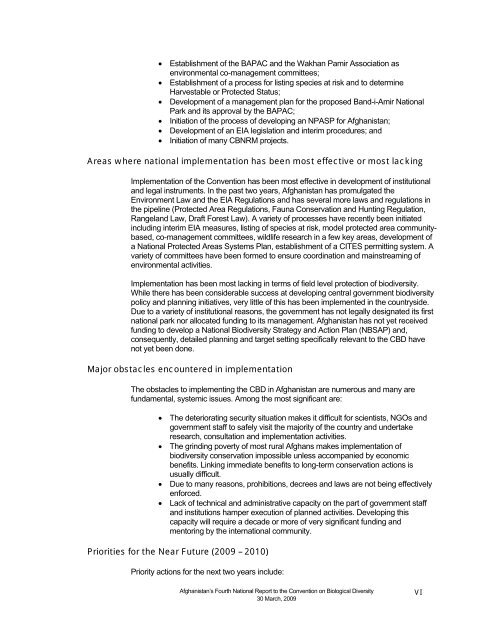Afghanistan's Fourth National Report to the Convention on ...
Afghanistan's Fourth National Report to the Convention on ...
Afghanistan's Fourth National Report to the Convention on ...
Create successful ePaper yourself
Turn your PDF publications into a flip-book with our unique Google optimized e-Paper software.
• Establishment of <str<strong>on</strong>g>the</str<strong>on</strong>g> BAPAC and <str<strong>on</strong>g>the</str<strong>on</strong>g> Wakhan Pamir Associati<strong>on</strong> asenvir<strong>on</strong>mental co-management committees;• Establishment of a process for listing species at risk and <str<strong>on</strong>g>to</str<strong>on</strong>g> determineHarvestable or Protected Status;• Development of a management plan for <str<strong>on</strong>g>the</str<strong>on</strong>g> proposed Band-i-Amir <str<strong>on</strong>g>Nati<strong>on</strong>al</str<strong>on</strong>g>Park and its approval by <str<strong>on</strong>g>the</str<strong>on</strong>g> BAPAC;• Initiati<strong>on</strong> of <str<strong>on</strong>g>the</str<strong>on</strong>g> process of developing an NPASP for Afghanistan;• Development of an EIA legislati<strong>on</strong> and interim procedures; and• Initiati<strong>on</strong> of many CBNRM projects.Areas where nati<strong>on</strong>al implementati<strong>on</strong> has been most effective or most lackingImplementati<strong>on</strong> of <str<strong>on</strong>g>the</str<strong>on</strong>g> <str<strong>on</strong>g>C<strong>on</strong>venti<strong>on</strong></str<strong>on</strong>g> has been most effective in development of instituti<strong>on</strong>aland legal instruments. In <str<strong>on</strong>g>the</str<strong>on</strong>g> past two years, Afghanistan has promulgated <str<strong>on</strong>g>the</str<strong>on</strong>g>Envir<strong>on</strong>ment Law and <str<strong>on</strong>g>the</str<strong>on</strong>g> EIA Regulati<strong>on</strong>s and has several more laws and regulati<strong>on</strong>s in<str<strong>on</strong>g>the</str<strong>on</strong>g> pipeline (Protected Area Regulati<strong>on</strong>s, Fauna C<strong>on</strong>servati<strong>on</strong> and Hunting Regulati<strong>on</strong>,Rangeland Law, Draft Forest Law). A variety of processes have recently been initiatedincluding interim EIA measures, listing of species at risk, model protected area communitybased,co-management committees, wildlife research in a few key areas, development ofa <str<strong>on</strong>g>Nati<strong>on</strong>al</str<strong>on</strong>g> Protected Areas Systems Plan, establishment of a CITES permitting system. Avariety of committees have been formed <str<strong>on</strong>g>to</str<strong>on</strong>g> ensure coordinati<strong>on</strong> and mainstreaming ofenvir<strong>on</strong>mental activities.Implementati<strong>on</strong> has been most lacking in terms of field level protecti<strong>on</strong> of biodiversity.While <str<strong>on</strong>g>the</str<strong>on</strong>g>re has been c<strong>on</strong>siderable success at developing central government biodiversitypolicy and planning initiatives, very little of this has been implemented in <str<strong>on</strong>g>the</str<strong>on</strong>g> countryside.Due <str<strong>on</strong>g>to</str<strong>on</strong>g> a variety of instituti<strong>on</strong>al reas<strong>on</strong>s, <str<strong>on</strong>g>the</str<strong>on</strong>g> government has not legally designated its firstnati<strong>on</strong>al park nor allocated funding <str<strong>on</strong>g>to</str<strong>on</strong>g> its management. Afghanistan has not yet receivedfunding <str<strong>on</strong>g>to</str<strong>on</strong>g> develop a <str<strong>on</strong>g>Nati<strong>on</strong>al</str<strong>on</strong>g> Biodiversity Strategy and Acti<strong>on</strong> Plan (NBSAP) and,c<strong>on</strong>sequently, detailed planning and target setting specifically relevant <str<strong>on</strong>g>to</str<strong>on</strong>g> <str<strong>on</strong>g>the</str<strong>on</strong>g> CBD havenot yet been d<strong>on</strong>e.Major obstacles encountered in implementati<strong>on</strong>The obstacles <str<strong>on</strong>g>to</str<strong>on</strong>g> implementing <str<strong>on</strong>g>the</str<strong>on</strong>g> CBD in Afghanistan are numerous and many arefundamental, systemic issues. Am<strong>on</strong>g <str<strong>on</strong>g>the</str<strong>on</strong>g> most significant are:• The deteriorating security situati<strong>on</strong> makes it difficult for scientists, NGOs andgovernment staff <str<strong>on</strong>g>to</str<strong>on</strong>g> safely visit <str<strong>on</strong>g>the</str<strong>on</strong>g> majority of <str<strong>on</strong>g>the</str<strong>on</strong>g> country and undertakeresearch, c<strong>on</strong>sultati<strong>on</strong> and implementati<strong>on</strong> activities.• The grinding poverty of most rural Afghans makes implementati<strong>on</strong> ofbiodiversity c<strong>on</strong>servati<strong>on</strong> impossible unless accompanied by ec<strong>on</strong>omicbenefits. Linking immediate benefits <str<strong>on</strong>g>to</str<strong>on</strong>g> l<strong>on</strong>g-term c<strong>on</strong>servati<strong>on</strong> acti<strong>on</strong>s isusually difficult.• Due <str<strong>on</strong>g>to</str<strong>on</strong>g> many reas<strong>on</strong>s, prohibiti<strong>on</strong>s, decrees and laws are not being effectivelyenforced.• Lack of technical and administrative capacity <strong>on</strong> <str<strong>on</strong>g>the</str<strong>on</strong>g> part of government staffand instituti<strong>on</strong>s hamper executi<strong>on</strong> of planned activities. Developing thiscapacity will require a decade or more of very significant funding andmen<str<strong>on</strong>g>to</str<strong>on</strong>g>ring by <str<strong>on</strong>g>the</str<strong>on</strong>g> internati<strong>on</strong>al community.Priorities for <str<strong>on</strong>g>the</str<strong>on</strong>g> Near Future (2009 – 2010)Priority acti<strong>on</strong>s for <str<strong>on</strong>g>the</str<strong>on</strong>g> next two years include:Afghanistan’s <str<strong>on</strong>g>Fourth</str<strong>on</strong>g> <str<strong>on</strong>g>Nati<strong>on</strong>al</str<strong>on</strong>g> <str<strong>on</strong>g>Report</str<strong>on</strong>g> <str<strong>on</strong>g>to</str<strong>on</strong>g> <str<strong>on</strong>g>the</str<strong>on</strong>g> <str<strong>on</strong>g>C<strong>on</strong>venti<strong>on</strong></str<strong>on</strong>g> <strong>on</strong> Biological Diversity30 March, 2009VI
















